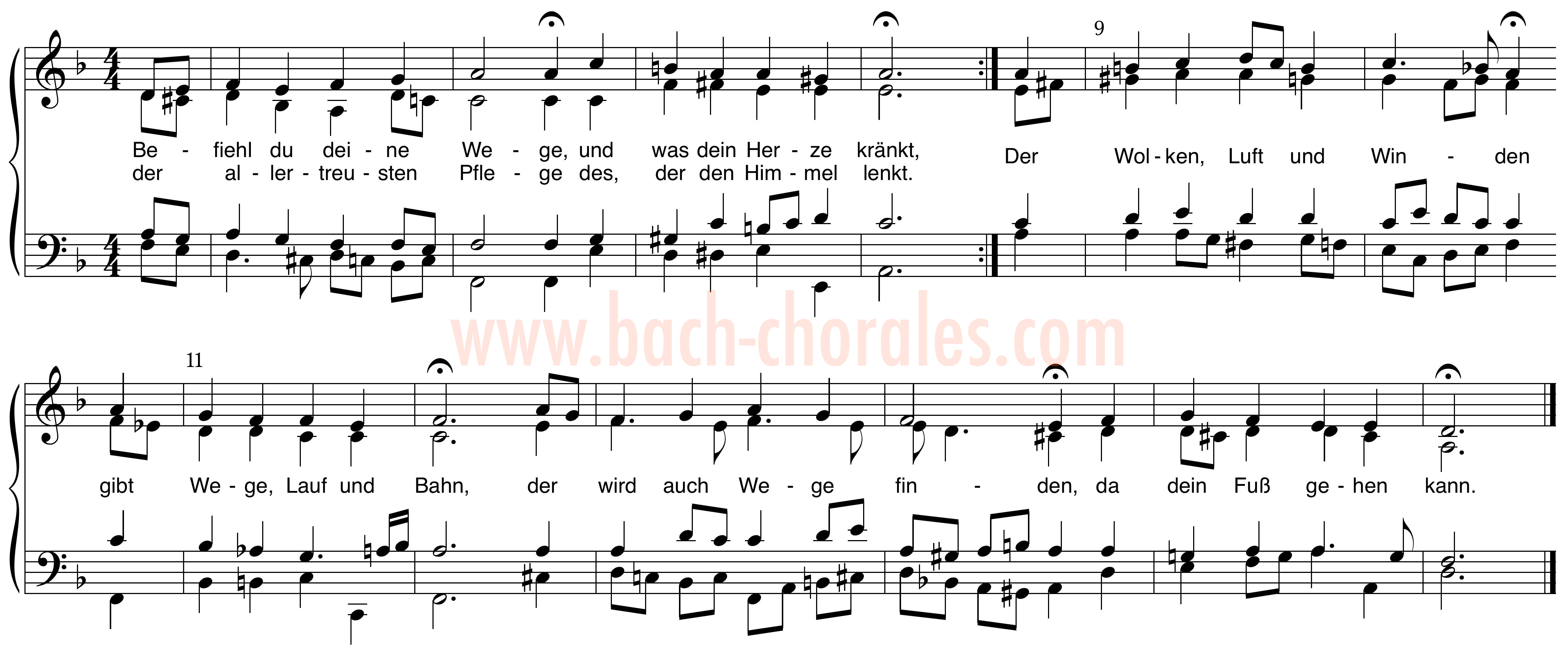 |





|
BWV 272

Previous: BWV 271
Next: BWV 273
Original source: Chorale, Befiehl du deine Wege, BWV 272
Chorale Text: Befiehl du deine Wege*, by Paul Gerhardt (1653)
Tune: Befiehl du deine Wege (melody #2), by Bartholomäus Gesius (1603) (Zahn 5393)
First Performance: Unknown
Appearance in Early Collections (Key):
Riemenschneider 340;
Breitkopf 339;
AmB 46II p.109;
Fasch p.132
Other Harmonizations: BWV
1126
Notes
This chorale survives without text. The text that appears here is the one provided by editors of the Bach Gesellschaft Ausgabe (BGA).
Question about Authenticity: This setting is among six that are attributed to Carl Philipp Emanuel Bach in the 1762 Fasch manuscript, a source which was lost in 1943 and recovered in 2001. Only this chorale and BWV 145a among those six settings found their way into the Birnstiel collection of Bach chorales first published a few years after the Fasch manuscript, and the two settings remained in the collection when published by Breitkopf in the 1780s. Whether this suggests that these two settings were eventually deemed authentic J.S. Bach compositions or whether they were included in the Birnstiel–Breitkopf Collection in error is difficult to answer.
On the matter, Schulze seems to take the first position: "Two settings from this group of six by CPE Bach nevertheless found their way into the Breitkopf Edition of the Bach chorales later on and thus they were in this manner assumed to be authentic settings by J. S. Bach." ("Zwei von diesen fanden allerdings später den Weg in die Breitkopf–Ausgabe der Bach–Choräle und wurden so in den Kanon der echten Choralsätze Johann Sebastian Bachs aufgenommen"). To read Hans–Joachim Schulze’s complete 2003 article summarizing the Fasch manuscript, see Jahrbuch des Staatlichen Instituts fur Musikforschung Preussischer Kulturbesitz, Vol. 2003 (2003), pages 9–31, particularly page 11.
However, even stronger evidence would suggest that BWV 145a is indeed by C.P.E. Bach, since the setting was attributed to him in two additional early manuscripts. (See the page devoted to BWV 145a for details.) This would suggest that the setting was in fact included in the Birnstiel–Breitkopf Collection in error, in which case the same error must be considered in relation to BWV 272.
Curiously, BWV 145a and BWV 272 are adjacent to each other in the AmB 46II manuscript (pages 108–109). If it can be asserted that BWV 145a and 272 are indeed settings by C.P.E. Bach, the implications are significant, for it casts a broad shadow over the authenticity of the AmB 46II manuscript (NBA Source C). And if a setting’s inclusion in the Birnstiel–Breitkopf publication, as well as in the manuscripts on which it is based, does not guarantee its authenticity, then the authenticity of the vast majority of the BWV 253–438 chorales cannot be confirmed with utmost confidence. (Related to this topic, see Gerd Wachowski’s 1983 Bach–Jahrbuch article in which, through an examination of the stylistic differences found in the BWV 253–438 chorales, he challenges the authenticity of these settings. ("Die vierstimmigen Choräle Johann Sebastian Bachs. Untersuchungen zu den Druckausgaben von 1765 bis 1932 und zur Frage der Authentizität," Bach–Jahrbuch, Vol. 69 (1983), pp. 51–79.)
bach–chorales.com by Luke Dahn. Copyright 2018.